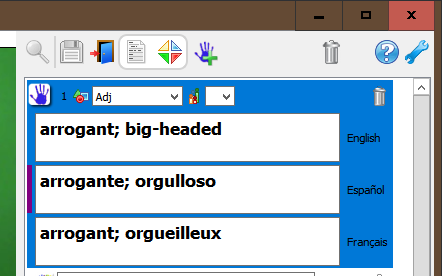Sometimes there is more than one written word that expresses the same meaning. For example, in English, "arrogant" and "big-headed" mean the same thing. Both words express the meaning of the same ASL sign. In the same way, both Spanish (Español) and French (Français) have two words for this meaning.
When this happens, you can give more than one gloss for a sense. Separate the glosses with a semicolon (;).

You can add as many glosses as you want. Think about how people might try to find a sign. Include words that they might use to find the sign. For ideas, look in a dictionary for the written language and find synonyms for a gloss.
To save your changes, click ![]() Save in the toolbar.
Save in the toolbar.

If you are done making changes, exit edit mode to go back to normal mode.

If you have made changes and haven't saved them yet, SooSL will remind you to save them.
Then, in normal mode, you will see all a sign's glosses in the gloss list. In this example, both "arrogant" and "big-headed" are in the gloss list. This means there are more glosses in the gloss list than there are signs. A sign can appear in the gloss list in more than one place, once for each gloss.
To show the video and other information about a sign, click any of its glosses in the gloss list.

This situation—one meaning with more than one translation— is different from two other situations. You should handle these three situations differently.
Created with the Personal Edition of HelpNDoc: Transform your help documentation into a stunning website